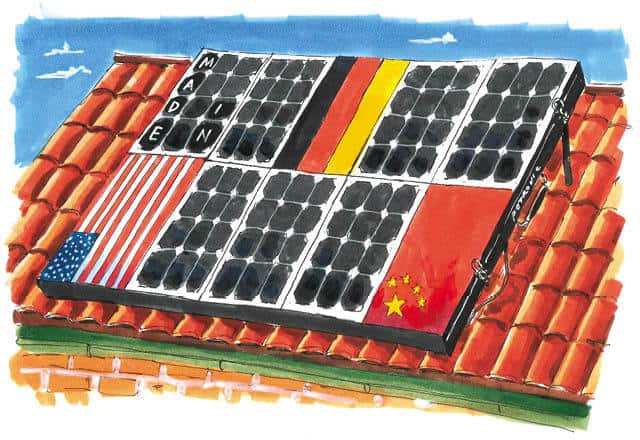Chinese panels… they really do stack up?
 Solar panels from China are not necessarily inferior, as they often use Western technology under licence. Phil Kreveld draws attention to other important quality and performance factors.
Solar panels from China are not necessarily inferior, as they often use Western technology under licence. Phil Kreveld draws attention to other important quality and performance factors.
Solar panels are manufactured in North America, China and Europe – mainly Germany.
Prices have been tumbling, and solar energy conversion efficiencies have been increasing.
ADVERTISEMENT
Panel selection is not dictated by price or technology, as much depends on external factors. Weather patterns, temperature and siting, to name a few, make the biggest differences in energy generation.
The three main production centres provide good-quality panels. Technology developed in Germany and elsewhere is used in Chinese factories run in partnership with local investors. So there is no primary reason to go for a German panel rather than a Chinese one on the basis of where they are made.
However, cutting-edge solar cell development can be found in several countries, including Australia. In our case it is lamentable that university research results drift off to other countries.
Installers of solar cannot be expected to pay attention to laboratory developments. Price, performance and durability – in that order – are their main concerns.
Polycrystalline and crystalline silicon are the commercially available panel types, then there are compound semiconductor materials such as CIGS, CdTe and CdS. Chinese panels are mainly based on silicon. The CIGS panel types manufactured in Europe and the United States have recently started to be made in China.
A large part of the academic research goes into basic science, mainly quantum efficiency and energy efficiency. There is a theoretical upper limit of 35% for solar cell efficiency (energy out over energy in). This is the Shockley Queisser limit, abbreviated as SQ.
In practice nothing gets close, although by stacking one PV junction on top of another, placing them in series, efficiency can be greatly improved. Tandem cell technology is expensive but becomes economically viable when used in conjunction with solar concentrators.
Bifacial solar is an older idea going through a renaissance with European and Chinese manufacturers. Both sides of the panel are employed to convert solar radiation. Vertically mounted panels use this concept, but there are weight disadvantages because of the protective glass on both sides.
Applications for bifacial cells include balconies, bus shelters, porch coverings, canopies, carports, facades, and fences.
In practice, energy conversion percentages vary from the low teens to the low twenties. For silicon, crystalline efficiency is better than for polycrystalline or amorphous silicon (the latter is used in thin panels, and is not as temperature sensitive – not much used in Australia).
The temperature de-rating factor can be a severe limitation on solar panels. When sunshine is greatest so is the temperature, and the result is often a net reduction in output.
Ambient temperature is no indication, as solar panels are light absorbent (also longer wavelength absorbent) and will experience much higher temperatures. For example, at 25°C, panel temperature might well be 50°C. A drop in output of 10% or more can occur just because of heat.
Surface treatment is important because pure silicon is shiny and can reflect up to 35% of the sunlight. To reduce the amount of sunlight lost, an anti-reflective coating is applied to the silicon wafer. The most commonly used coatings are titanium dioxide and silicon oxide.
Thin panel technology is becoming more popular in Europe. It also requires back surface treatment to increase light trapping, in particular for the near infra-red wavelengths. The use of gratings on the back surface increases light trapping and overall efficiency.
Rating the performance of solar panels from a large list of manufacturers is a daunting task. The international journal Photon evaluates panels and inverters on a scientific basis, sometimes for years.
The primary number is ‘yield’, the ratio of kilowatt/hours (generated over a fixed period) to kilowatt power rating. The tests are conducted during Northern Hemisphere summers and winters.
The October 2014 issue of Photon indicates that the best yield rating was for a Chinese mono-crystalline panel installed in 2013. A close inspection of the 110 listed products reveals that most are from Chinese manufacturers. However, it is difficult to know the extent of joint ventures, technology agreements, licences, etc.
Ratings also take durability into account, so quality and certification issues are important rather than the underlying science. Panel scratches, cracks caused by poor soldering, and damaged charge-transfer fingers are likely to affect output and longevity.
Certification is important as a measure of trust. However, some certification is not genuine. Certification bodies include TUV Rheinland, TUV Sud, VDE (all in Germany), SGS (Switzerland) and Intertek (United States).
Solar panel samples need to be submitted following a factory audit, then accelerated tests including mechanical and temperature tests lasting several months. International certifications include IEC 61215, IEC 61646 (specific for thin film panels) and IEC 61730 for electrical safety.
Electrical safety aspects, as covered by the IEC Standard, are often unsatisfactory. Failure of the wet leakage test due to faulty connectors is not a rare event.
Part of the problem is that there is no Standard covering PV connectors. The nearest one that could be used is EN50521, which covers thermal cycles and damp heat testing. According to TUV, wet leakage current is one of the most frequent failures.
In the Australian market, the performance and durability of products from China and Europe are generally warranted. However, watch out for parallel imports which have no valid warranty or may be rebranded products.
-
ADVERTISEMENT
-
ADVERTISEMENT

